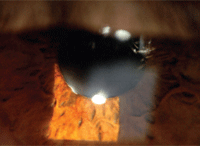 Dry eye and other forms of ocular surface disease (OSD) are commonplace in daily optometric practice. Many dry eye patients respond well to basic treatments, such as anti-inflammatory medications, antibiotics and artificial tears.
Dry eye and other forms of ocular surface disease (OSD) are commonplace in daily optometric practice. Many dry eye patients respond well to basic treatments, such as anti-inflammatory medications, antibiotics and artificial tears.
However, some cases of OSD do not respond well to these conventional therapies. Why? Because most unresponsive cases of OSD are caused by an underlying systemic condition. And until that systemic condition is controlled, the ocular surface will not fully heal.
Diabetes and OSD
With an aging Baby Boomer generation, the incidence of various systemic diseases will increase during the next decade. However, certain diseases, such as type 2 diabetes, have already reached epidemic proportions in the United States. Diabetes affects more than 11% of Americans, and its treatment costs are estimated to be $218 billion per year.1
Most eye care professionals speak extensively on the connection between diabetes and the development of retinopathy or macular edema. However, one of the most common––and often overlooked––ocular manifestations of diabetes is dry eye disease.1-3
The Beaver Dam Eye Study showed that nearly 20% of participants between ages 43 and 86 with type 2 diabetes had dry eye.4 Another study by Milton Hom, O.D., indicated that 53% of patients with either diabetes or borderline diabetes reported clinically significant dry eye.5 One other study showed that 55% of patients with diabetes had at least mild dry eye signs and symptoms throughout the day.2

This diabetes patient could be at risk for dry eye.
It’s the combination of comorbidity, however, that makes it essential to manage the treatable ocular manifestations of diabetes. In 2008, for example, multiple studies confirmed that between 12,000 and 24,000 Americans with diabetes became legally blind from diabetic retinopathy.6,7 However, these studies also indicated that nearly three times as many diabetes patients suffered comorbidities that resulted in significant vision loss, including OSD.6 Additional research documented that the relationship between advanced diabetic retinopathy and increased tear dysfunction was directly proportional.7 More specifically, patients with proliferative diabetic retinopathy exhibited significantly less tear film function than patients with non-proliferative retinopathy.7
Theories for why dry eye is so prevalent in patients with diabetes range from autonomic dysfunction to involvement of aldose reductase in the sorbitol pathway.8,9 A more recent study showed that diabetes induced histological alterations in the lacrimal gland in mice.10 This finding also suggests that hyperglycemia-related oxidative stress may precipitate diabetic dry eye syndrome.10
Finally, an extensive study of 199 type 2 diabetes patients revealed that 54% of participants had dry eye syndrome.11 Consequently, the authors concluded that dry eye assessment should be an integral part of a diabetic eye examination.
Other Systemic Diseases
• Rheumatoid arthritis (RA). Patients with RA often experience signs and symptoms of dry eye disease. Research on RA patients in the United Kingdom revealed that more than 70% of the subjects tested positive for dry eye disease.12 (Surprisingly, just 12% of patients were currently being treated for OSD.) And, similar to diabetes, it appears that the more severe the patient’s RA, the more significant his or her dry eye symptoms.13
• Systemic lupus erythematosus (SLE). Many SLE patients also have been diagnosed with dry eye. In a study of 36 patients with SLE, 57% had pathological dry eye.14
• Thyroid eye disease. Because of hormonal changes and exophthalmos-related corneal exposure, thyroid eye disease is a common systemic disease associated with dry eye.15
• Inflammatory conditions. Several inflammatory conditions, including irritable bowel syndrome and Crohn’s disease, have a high incidence of dry eye. One prospective study on patients with inflammatory bowel syndrome showed a 22% prevalence of dry eye disease compared to an 11% incidence in age- and gender-matched controls.16
• Dermatological conditions. Several dermatological conditions, such as rosacea, have a high incidence of OSD. Additionally, patients with psoriasis have an increased likelihood to develop dry eye.17 In one study of psoriasis patients, 50% showed significant conjunctival impression cytology differentiation that was indicative of OSD compared to just 5% of patients in the control group.18
Pediatric Considerations
Clinicians must be particularly vigilant about the treatment of dry eye secondary to systemic disease in children. We rarely see dry eye disease in otherwise healthy pediatric patients. So, when it does occur, you must consider the presence of an underlying systemic condition.
One study examined 14 pediatric patients (aged one to 17 years) who were diagnosed with dry eye and advanced ocular surface damage. When the patients’ histories were explored, all 14 individuals tested positive for at least one concurrent systemic condition (ranging from Riley-Day syndrome to graft-versus-host disease). The authors concluded that early manifestations of dry eye in childhood are a potential indicator of systemic disease.19
Another study found that 15% of children with type 1 diabetes complained of dry eye symptoms compared to just 2% of children in the control group.20 The researchers also documented significant dry eye signs in about 8% of the children with diabetes compared to less than 1% in healthy, age-matched controls.20
One additional study revealed that 11% of patients with juvenile rheumatoid arthritis (JRA) experienced dry eye symptoms compared to just 1.5% of controls.21 The authors also concluded that basal tear secretion and tear film stability were lower in children with JRA.
The bottom line: Dry eye in a pediatric patient warrants a systemic work-up.
Treatment Strategies
When patients present with ocular complications that are caused by a systemic disease, you must not only treat the ocular symptoms, but also manage the underling condition.
For example, because diabetes causes metabolic, neuropathic and vascular tissue damage that leads to an inflammatory process and functional degeneration of the lacrimal gland and ocular surface, you should prescribe antioxidants (nutritional supplements), anti-inflammatory agents (topical corticosteroids and immunomodulatory medications) and/or anabolic agents that mimic insulin-related effects.22 Also, autologous serum is one particular topical medication that has been shown to significantly improve the ocular surface of patients with diabetes.23
In another study, researchers suggested that artificial tears with hyaluronic acid demonstrated greater efficacy than other ocular lubricants in patients with dry eye secondary to Sjögren’s syndrome.24 This study also showed that topical cyclosporine and similar imunomodulating agents were the most effective treatment for dry eye associated with Sjögren’s.24
One additional study indicated that episcleritis, anterior uveitis and dry eye secondary to SLE responded well to topical treatment; however, more advanced cases that involved manifestations of retinopathy and scleritis could not be controlled without systemic immunosuppression.25
The prevalence of concurrent systemic disease and dry eye continues to grow at an alarming rate. But, understanding the association between these systemic conditions and OSD will help you more effectively diagnosis and manage your patients.
Dr. Karpecki is a consultant to Allergan and Abbott Medical Optics, but has no direct financial interest in any of the products mentioned.
1. Dall TM, Zhang Y, Chen YJ, et al. The economic burden of diabetes. Health Aff (Millwood). 2010 Feb;29(2):297-303.
2. Binder A. Sjögren’s syndrome: association with type-1 diabetes mellitus. Br J Rheumatol. 1989 Dec;28(6):518-20.
3. Perry HD, Foulks GN, Thoft RA, Tolentino FI. Corneal complications after closed vitrectomy through the pars plana. Arch Ophthalmol. 1978 Aug;96(8):1401-3.
4. Klein R, Klein BE, Linton KL, De Mets DL. The Beaver Dam Eye Study: visual acuity. Ophthalmology. 1991 Aug;98(8):1310-5.
5. Hom M, De Land P. Self-reported dry eyes and diabetic history. Optometry. 2006 Nov;77(11):554-8.
6. Tumosa N. Eye disease and the older diabetic. Clin Geriatr Med. 2008 Aug;24(3):515-27, vii.
7. Yu L, Chen X, Qin G, et al. Tear Film function in type 2 diabetic patients with retinopathy. Ophthalmologica. 2008;222(4):284-91.
8. Ramos-Remus C, Suarez-Almazor M, Russell AS. Low tear production in patients with diabetes mellitus is not due to Sjogren’s syndrome. Clin Exp Rheumatol. 1994 Jul-Aug;12(4):375-80.
9. Fujishima H. Improvement of corneal sensation and tear dynamics in diabetic patients by oral aldose reductase inhibitor, ONO-2235: a preliminary study. Cornea. 1996 Jul;15(4):368-75.
10. Modulo CM, Jorge AG, Dias AC, et al. Influence of insulin treatment on the lacrimal gland and ocular surface in diabetic rats. Endocrine. 2009 Aug;36(1):161-8.
11. Manaviat MR, Rashidi M, Afkhami-Ardekani M, et al. Prevalence of dry eye syndrome and diabetic retinopathy in type 2 diabetic patients. BMC Ophthalmol. 2008 Jun 2;8:10.
12. Piper H, Douglas KM, Treharne GJ, et al. Prevalence and predictors of ocular manifestations of RA: is there a need for routine screening? Musculoskeletal Care. 2007 Jun;5(2):102-17.
13. Wolfe F, Michaud K. Prevalence, risk, and risk factors for oral and ocular dryness with particular emphasis on rheumatoid arthritis. J Rheumatol. 2008 Jun;35(6):1023-30.
14. Ostanek L. Ocular manifestations in patients with systemic lupus erythematosus and antiphospholipid syndrome. Pol Arch Med Wewn. 2007;117 Suppl:18-23.
15. Moss SE, Klein R, Klein BE. Long-term incidence of dry eye in an older population. Optom Vis Sci. 2008 Aug;85(8):668-74.
16. Felekis T, Katsanos K, Kitsanou M, et al. Spectrum and frequency of ophthalmologic manifestations in patients with inflammatory bowel disease: a prospective single center study. Inflamm Bowel Dis. 2009 Jan; 15(1):29-34.
17. Jager K. Functional relationship between cationic amino acid transporters and beta-definsins: implications for dry eye skin diseases and dry eye. Ann Anat. 2010 Apr 20;192(2):65-9.
18. Karabulut AA, Yalvac IS, Vahaboglu H, et al. Conjunctival impression cytology and tear-film changes in patients with psoriasis. Cornea. 1999 Sep;18(5):544-8.
19. Mac Cord Medina F, Silvestre de Castro R, Leite SC, et al. Management of dry eye related to systemic diseases in childhood and long-term follow-up. Acta Ophthalmol Scand. 2007 Nov;85(7):739-44.
20. Akinci A, Cetinkaya E, Aycan Z. Dry eye syndrome in diabetic children. Eur J Ophthalmology. 2007 Nov-Dec;17(6):873-8.
21. Akinci A, Cakar N, Uncu N, et al. Keratoconjunctivitis sicca in juvenile rheumatoid arthritis. Cornea. 2007 Sep;26(8):941-4.
22. Alves Mde C, Carvalheira JB, Modulo CM, et al. Tear film and ocular surface changes in diabetes mellitus. Arq Bras Oftalmol. 2008 Nov-Dec;71:96-103.
23. Schulze SD, Sekundo W. Autologous serum for the treatment of corneal epithelial abrasions in diabetic patients undergoing vitrectomy. Am J Ophthalmol. 2006 Aug;142(2):207-11.
24. Baudouin C, Pisella PJ, Brignole F. Current treatment of xerophthalmia in Sjögren’s syndrome. Rev Med Intern. 2004 May;25(5):376-82.
25. Sivaraj RR, Durrani OM, Denniston AK, et al. Ocular manifestations of systemic lupus erythematosus. Rheumatology (Oxford). 2007 Dec;46(12):1757-62.

